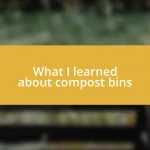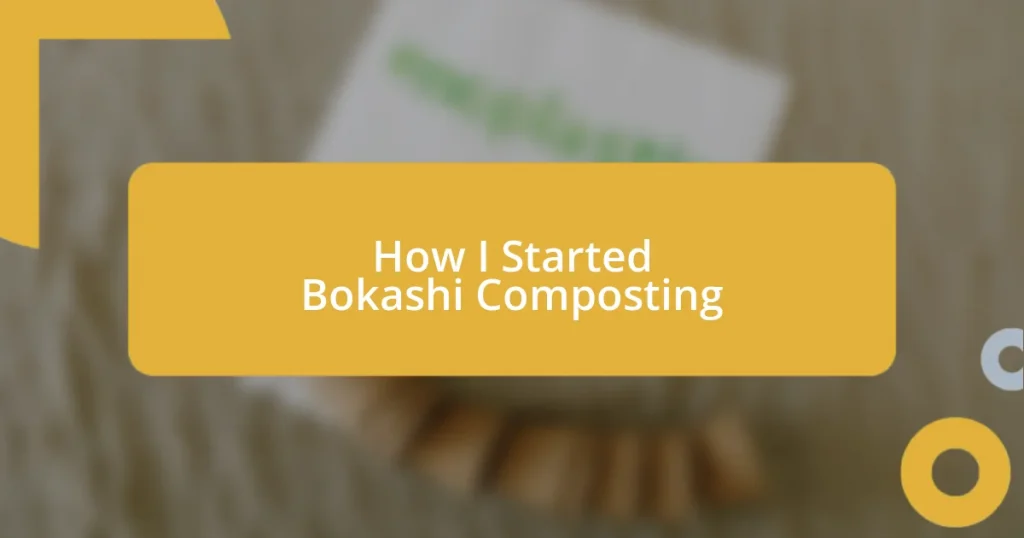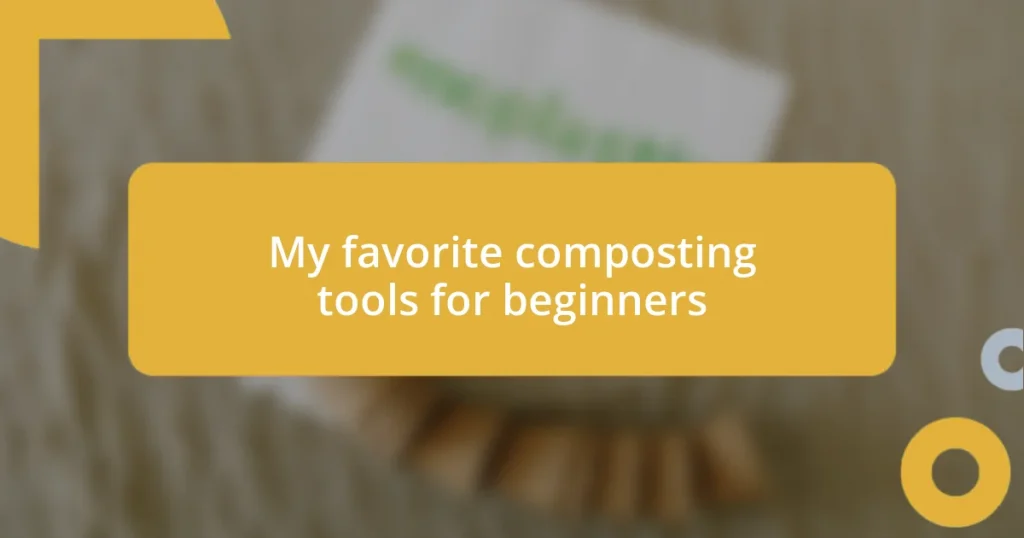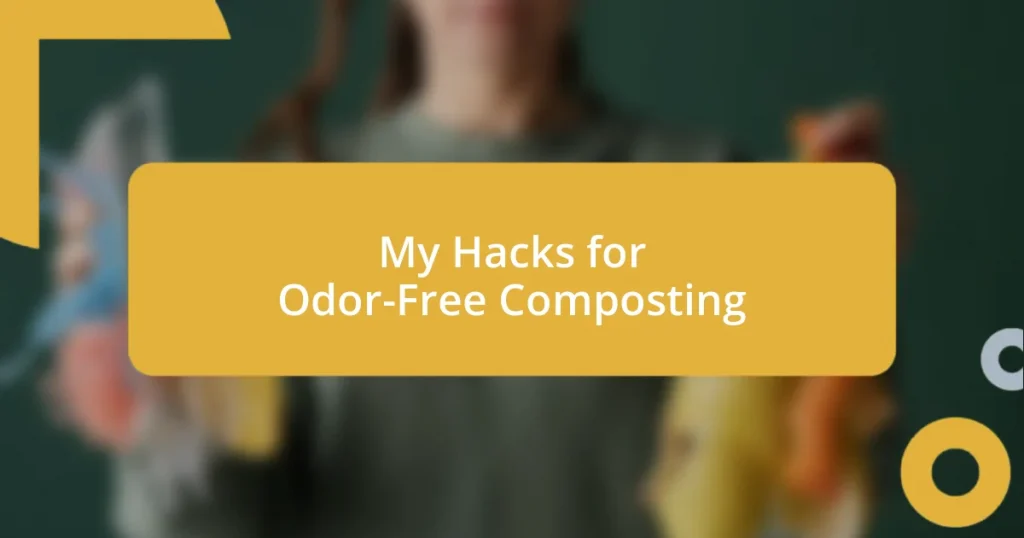Key takeaways:
- Bokashi composting utilizes anaerobic fermentation, allowing for composting of all organic waste, including meat and dairy, while minimizing odors and requiring less space.
- Essential supplies for Bokashi composting include a sealed Bokashi bucket, Bokashi bran for fermentation, a drain tap to collect nutrient-rich bokashi juice, and a moisture source to maintain optimal conditions.
- Key maintenance practices involve limiting bucket openings to preserve the anaerobic environment, managing moisture levels, and allowing at least two weeks for fermentation to achieve rich compost.

Understanding Bokashi Composting Basics
Bokashi composting is a unique method that differs significantly from traditional composting. Instead of relying on aerobic decomposition, it uses anaerobic fermentation, which means that the waste doesn’t rot but ferments. I remember the first time I opened my Bokashi bucket; the smell was slightly pungent but oddly satisfying—it felt like I was unlocking a hidden power within my kitchen scraps.
One of the fascinating aspects of Bokashi is its ability to compost anything organic, including meat and dairy, which many traditional composting methods discourage. This versatility truly intrigued me as I often had these leftovers frustratingly going to waste. Have you ever wondered how convenient it would be to compost all your food scraps without worry? I found this approach not only practical but also empowering, realizing that I could reduce my waste significantly.
Moreover, the process involves using a special inoculated bran, rich in beneficial microorganisms. This bran kickstarts the fermentation process, and seeing those tiny granules was like discovering a secret ingredient for success in my composting journey. I often felt a surge of excitement each time I added more scraps, knowing I was contributing to a sustainable cycle that benefited both my garden and the environment. Isn’t it incredible how you can turn potential waste into a valuable resource?

Benefits of Bokashi Composting
Bokashi composting offers a wealth of advantages that truly stand out. One of the biggest benefits I’ve experienced is how quickly it turns food waste into nutrient-rich compost. Just a couple of weeks after starting, I could see substantial change—it’s almost like having a superpower in your kitchen! Plus, it’s a clean process; I never had to deal with the odors that sometimes come with traditional composting.
Here are some key benefits of Bokashi composting:
- Versatile Waste Management: Compost all organic materials, including meat, dairy, and even cooked food.
- Space Efficient: Requires less space than traditional compost piles, making it perfect for urban living.
- Quick Turnaround Time: Transforms waste into compost within a matter of weeks.
- Odor-Free Process: Unlike regular composting, it minimizes odors, making it more pleasant to manage.
- Enhanced Soil Health: The end product enriches soil with beneficial microorganisms, promoting plant growth.
Reflecting on my own experience, I remember the time I cleared out leftovers from my fridge that I usually dreaded throwing away. Instead of feeling guilty about food waste, I felt a sense of accomplishment, knowing I was contributing to a cycle that supports my garden. This emotional transformation is one of the underrated perks of Bokashi composting; it gives you a deeper connection to not just waste but to what we consume and how it can ultimately nourish our earth.

Essential Bokashi Composting Supplies
When I first delved into Bokashi composting, gathering the essential supplies felt like assembling a new gadget. The core items you’ll need include a Bokashi bucket with a tight-fitting lid, which I found to be crucial in controlling the odor—trust me, an airtight seal makes all the difference. Alongside the bucket, you’ll require Bokashi bran. The first time I added this bran to my scraps, I was pleasantly surprised by its earthy fragrance; it felt like adding a sprinkle of magic to my composting process.
Another critical item is a tap at the bottom of your bucket. This feature allows easy draining of liquid, which is collected as “bokashi juice.” When I first tried using this liquid in my garden, I was amazed by how it nourished my plants, turning them vibrant green. It’s like giving your plants a little boost of energy every time you drain your bucket!
Lastly, don’t forget a source of moisture, such as a spray bottle filled with water. I learned the importance of this when I noticed my scraps seemed dry. A little misting encouraged the fermentation process, and my enthusiasm soared as I realized I could control that aspect of the process easily.
| Supply | Purpose |
|---|---|
| Bokashi bucket | Holds scraps and promotes anaerobic fermentation |
| Bokashi bran | Inoculated with microorganisms, essential for fermentation |
| Drain tap | Collects liquid fertilizer (bokashi juice) |
| Moisture source | Ensures optimal fermentation conditions |

Step by Step Bokashi Process
To start the Bokashi process, I first set up my Bokashi bucket. It felt almost like creating a new recipe! I layered my kitchen scraps, ensuring to chop them into smaller pieces. This little step might sound tedious, but I quickly learned it dramatically speeds up the fermentation process. Have you ever wished for a way to instantly reduce your waste? This is where Bokashi shines, giving you a tidy solution to food scraps.
Once the scraps were in, I generously sprinkled Bokashi bran over the top. The first time I did this, I was taken aback by how satisfying it felt to know I was actively participating in a cycle, turning waste into something beneficial. It’s fascinating how that simple act can create a bubbling excitement, as I anticipated the transformation to compost. I always wondered if I could really impact my environment—Bokashi proved I could.
After sealing the bucket, I made it a habit to drain the liquid every few days. Seeing the bokashi juice fill up was like a mini celebration in my home! It’s funny how something as simple as nutrient-rich liquid can contribute to plant health and enhance garden fertility. I often found myself daydreaming about how my plants were thriving on what would have been waste, reinforcing my commitment to this sustainable approach. What can be more gratifying than nourishing your garden with something you created?

Maintaining Your Bokashi System
Maintaining your Bokashi system is all about consistency. I discovered early on that opening the bucket too often could disrupt the anaerobic environment, so I set a routine—only opening it to add scraps and drain the bokashi juice. This habit not only preserved the fermentation, but it also added an element of anticipation to my daily chores. Have you ever looked forward to something as simple as lifting the lid and checking on your progress? That excitement kept me engaged.
Another key aspect is managing moisture levels. Initially, I underestimated how crucial proper moisture was for good fermentation. When I noticed my scraps weren’t breaking down as expected, I quickly realized I hadn’t been misting them enough. That “ah-ha” moment taught me that a couple of spritzes could mean the difference between a neglected bucket and a thriving composting system. I remember standing there, spray bottle in hand, feeling a bit like a scientist in a lab—excited to experiment and see improvements.
It’s also important to keep an eye on the fermentation time. I made the mistake of rushing the process once, thinking shorter would be better. Instead, I learned to let everything sit for a minimum of two weeks before burying it in the soil. That extra week allowed the fermentation to reach its full potential, creating rich compost that positively transformed my garden. Do you see potential in what might seem like just scraps? Once you embrace this patience, you’ll witness the incredible transformation that can happen right in your own home.

Troubleshooting Common Bokashi Issues
If you find an unusual smell emanating from your Bokashi bucket, it’s a sign something is off. I once had a batch that started to smell somewhat sour and vinegary, which was honestly alarming at first! That pungency suggested my anaerobic environment had been compromised—likely from opening the bucket too frequently or adding too wet scraps. I quickly adopted a stricter schedule of checks to maintain that vital airtight condition, and it made a world of difference.
Another challenge I faced was the occasional presence of mold on the scraps. Initially, I panicked when I saw those fuzzy spots, thinking I’d ruined everything. But the truth is, a little mold can be normal, especially if you mix in high-moisture items like fruits. I learned to scrape off the moldy bits and, more importantly, I adjusted my layering technique by adding dryer materials like shredded paper to balance the moisture. Have you ever had that sinking feeling that you messed up? It’s a learning experience that can actually improve your Bokashi game!
You might notice that your compost isn’t breaking down as smoothly as it should, which can be frustrating. I went through this phase where it felt like my bucket was just a waiting game with no results! But this prompted me to investigate and realize that I hadn’t been using enough Bokashi bran. A good rule of thumb I picked up is to make sure every layer of scraps gets a generous sprinkling of bran. This not only kickstarts fermentation but also fosters the beneficial microbes that do all the hard work. Have you ever found yourself right at the brink of a breakthrough, only to realize it was just a small detail holding you back? Trust me, small adjustments lead to big changes in the Bokashi process!















